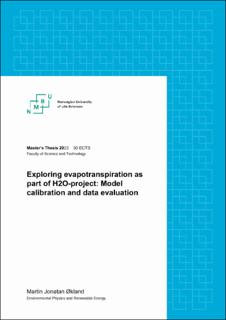| dc.description.abstract | The atmosphere’s mass is about 5.1480 × 1018 kg where water vapor amounts to about 0.25 %.
This tiny fraction of water vapor is a key greenhouse gas, and is essential in the hydrological,
meteorological and biological processes. An important component in the land-atmosphere domain
is evapotranspiration (evaporation and transpiration together). For about 75 years, studies have
been conducted to give good predictive evapotranspiration models. However, results show that
different models yield different accuracy in their spatiotemporal application.
As part of the Norwegian Meteorological Institute’s project; Hydrometeorology to Operations
(H2O), this thesis will study evapotranspiration to evaluate evapotranspirational models, Priestley-
Taylor and Penman-Monteith, and evaluate evapotranspirational data from remote sensing and
pan evaporation.
Five versions of the Priestley-Taylor (PT) model were evaluated, of which four were hourly-based.
One of the models used the standard α of 1.29. One model was based on the approach from Cristea
et al. (2013) to calculate α. The two other hourly-based models required programming with curve-
fitting, where one used curve-fitting to calculate α and γ, while the other one used curve-fitting for
α only. The fifth PT model was daily-based with an α value calculated by curve-fitting. The best
PT model had α values between 0.2755 and 0.3789 with an RMSE compared to measurements of
0.0043.
Four versions of the Penman-Monteith (PM) model were evaluated, of which two were daily-based
and two were hourly-based. The first daily-based PM model calculated actual evapotranspiration
directly and resulted in significant underestimations. The other PM models calculated reference
evapotranspiration before being multiplied by a crop coefficient. The second daily-based and the
first hourly-based PM models used a crop coefficient of 0.9, while the second hourly-based PM
model used curve-fitting to calculate a suitable crop coefficient of 0.588. The best PM model was
the hourly-based with the calibrated crop coefficient, resulting in an RMSE value of 0.0039.
Remote sensing measurements were evaluated by comparing them to eddy-covariance measure-
ments. The remote sensing measurements were about 30-40 % greater than the eddy-covariance
measurements. It was however not found out if this is a systematic error or just a coincidence.
Pan evaporation measurements were evaluated by converting them into estimates of actual evapo-
transpiration and comparing them to eddy-covariance measurements. Crop coefficients of 0.9 and
0.588 were used in this conversion. It was found that on an hourly basis, the conversion using a crop
coefficient of 0.588 yielded the most accurate result compared to eddy-covariance measurements.
This thesis has proven that an hourly-based PM model with crop coefficient of 0.588 is more
accurate than a PT model with α of between 0.2755 and 0.3789. It has also been proven that
the literature-based PM model is more accurate than the literature-based PT model. The overall
conclusion of all evaluations is that more extended time series’ are needed to reach a conclusive an-
swer. However, the results seem promising as proof of concept that calibrating evapotranspirational
models could yield valuable predictions, and that data from remote sensing and pan evaporation
could be reliable. | |
